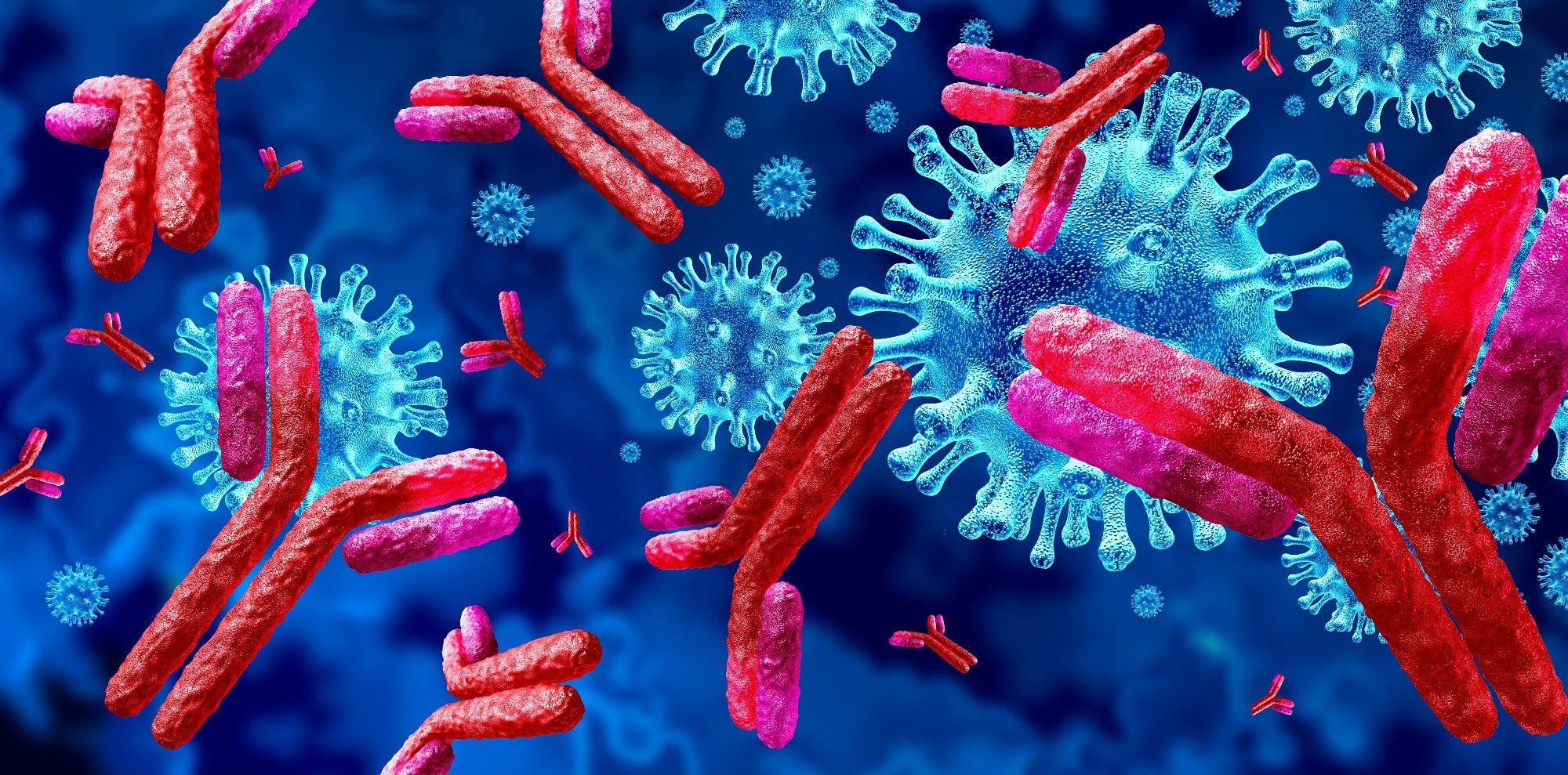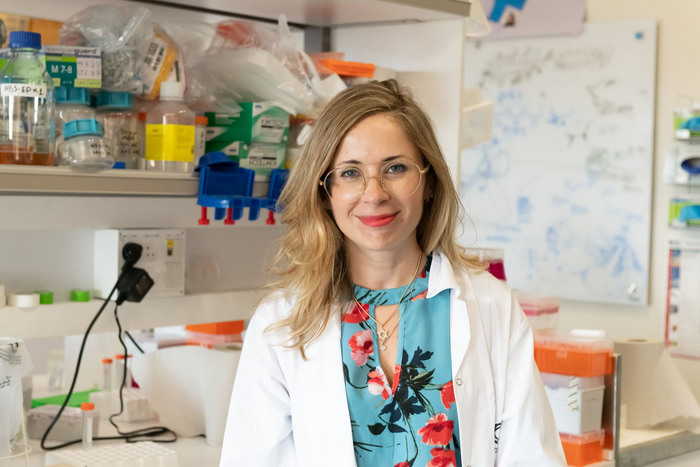In a recent study published in the journal Communications Biology, researchers evaluated the efficacy of monoclonal antibodies (mAbs) from severe acute respiratory syndrome coronavirus 2 (SARS-CoV-2) ancestral Wuhan-1-strain-infected convalescent donors against SARS-CoV-2 VOCs (variants of concern) such as Alpha, Beta, Gamma, Delta, and Omicron.
 Study: Conformational flexibility in neutralization of SARS-CoV-2 by naturally elicited anti-SARS-CoV-2 antibodies. Image Credit: Lightspring / Shutterstock
Study: Conformational flexibility in neutralization of SARS-CoV-2 by naturally elicited anti-SARS-CoV-2 antibodies. Image Credit: Lightspring / Shutterstock
The continual emergence of SARS-CoV-2 VOCS has threatened the efficacy of vaccines and immune protection conferred by natural SARS-CoV-2 infections with the ancestral Wuahn-Hu-1 strain. Therefore, it is crucial to assess the cross-neutralizing potency of serological Abs. Further, the structural basis for SARS-CoV-2 neutralization needs to be investigated to predict the effects VOC modifications would have on Ab cross-reactivity.
The authors of the present study previously identified nine SARS-CoV-2 neutralizing mAbs from the sera of two coronavirus disease 2019 (COVID-19) convalescents infected probably with the ancestral strain. Of these, seven mAbs (TAU-2310, TAU-2303, TAU-2230, TAU-2212, TAU-2189, TAU-1145, and TAU-1109) demonstrated potent SARS-CoV-2 neutralization, whereas the remaining two mAbs (TAU-2220 and TAU-1115) showed lower potency.
All mAbs (except TAU-2212) were highly bound to the SARS-CoV-2 spike (S) protein and its receptor-binding domain (RBD), whereas TAU-2212 was bound to an unidentified conformational site on SARS-CoV-2 S. While mAbs neutralized the ancestral strain, their cross-neutralization potency against SARS-CoV-2 VOCs was not known.
About the study
In the present study, researchers extended their previous analysis by investigating the neutralization breadth and mechanistic basis for SARS-CoV-2 VOC neutralization by mAbs isolated previously from convalescent Wuhan-Hu-1-infected donors.
Flow cytometry (FC) analysis was performed to assess mAbs’ ability to inhibit binding interactions between human angiotensin-converting enzyme 2 (hACE2) and S proteins of the ancestral strain and Alpha, Beta, and Delta VOCs. In addition, prevention of SARS-CoV-2 infection by mAbs was assessed by pseudovirus and authentic virus neutralization assays using Vero-TMPRSS2 (transmembrane serine protease 2) cells.
Structural analyses were performed using X-ray crystallography and cryo-EM (cryo-electron microscopy) to explore the mechanistic basis of SARS-CoV-2 VOC neutralization by TAU-2212 and TAU-2303 and to investigate the contribution of VOC mutations to Ab escape. Conformational structures of the Abs were determined at resolutions of 3.3 Å, 4.7 Å, 6.4 Å, 7.3 Å, and 9.4 Å, respectively.

Dr. Natalia Freund / Tel Aviv University
Results
The most potent mAbs detected were directed predominantly against the ACE2 binding site (ACE2bs) and showed higher sensitivity to SARS-CoV-2 devolution than non-ACE2bs mAbs (TAU-2310, TAU-2220, TAU-1109, and TAU-1115), two of which retained their neutralization potency against all VOCs analyzed. Binding efficiencies of all ACE2bs mAbs (mAbs TAU-1145, TAU-2189, TAU-2230, and TAU-2303) to all VOCs were reduced except for Alpha, with the most significant reductions for the Beta VOC, Delta VOC and the Omicron VOC and lesser for the Gamma VOC.
Among ACE2bs mAbs, none retained its original neutralization potency against the Beta VOC and only TAU-2303 retained (and showed higher than original) neutralization potency against the Delta VOC. No effects were observed for TAU-1109, -2310, -1115, and -2220 mAbs since SARS-CoV-2 neutralization did not occur via receptor blocking.
The L452R mutation (in Delta VOC) and E484K mutation (in Beta VOC and Gamma VOCs) majorly impacted Ab binding. Further, RBDs comprising N439K, Y453F, and A475V single mutations showed binding with all mAbs as efficiently as with the ancestral strain RBD. TAU-2303 binding to the K417N/N501Y doubly mutated RBD was decreased, although the mutations showed no significant effect individually.
TAU-2212 demonstrated 25 to 40% ACE2:S inhibition when tested against the ancestral strain, Alpha and Delta VOCs, but showed no activity against the Beta VOC. The Alpha VOC and the ancestral strain showed similar behavior, whereas Beta and Omicron VOCs showed the highest neutralization resistance, followed by the Gamma VOC and the Delta VOC.
Structural analysis of Delta VOC-neutralizing ACE2bs mAb, the fragment of antigen-binding (Fab) of TAU-2303 (Fab2303) complexed with SARS-CoV-2 S at 4.5 Å and S RBD at 2.4 Å showed similar binding modes as that between S RBD and hACE2 with RBD in the “up” RBD conformation. The majority of the Fab2303-RBD contact surface (64%) was derived from the Fab2303 heavy chain (HC, 19 residues), whereas only 36% (10 residues) was derived from the light chain.
The combination of RBD mutations may alter SARS-CoV-2 resistance; Omicron has mutations in seven residues in the Fab2303 binding epitope, including Q493, Q498, Y505, and K417, providing the structural explanation for the lack of Omicron neutralization by the TAU-2303 mAb. The E484K mutation disrupted hydrogen bonds between the TAU-2212 and the RBD, providing a structural explanation for the lack of Beta and Gamma VOC neutralization by TAU-2212.
Five conformational structures of the TAU-2212-SARS-CoV-2 S complex were assessed at several resolutions. TAU-2212 showed binding with an exclusive quaternary epitope and a flexible [fragment crystallizable (Fc) region] and unique neutralization mode involving transitions between the conformations.
TAU-2212 showed one to three Fabs binding to either one SARS-CoV-2 S trimer or cross-linking adjacent S trimers by forming both intra-S and inter-S contacts, and favoring RBD in the “down” position. Epitope recognition by TAU-2212 primarily involved the HCDR (heavy complementarity-determining region) loops and S RBD1 and RBD2 regions and 57 residues.
Overall, the study findings provided valuable mechanistic and structural insights into SARS-CoV-2 VOC neutralization by mAbs with molecular modeling predictions of mAb interactions with Omicron.